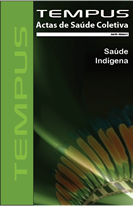Resumo
This study reconstitutes the implantation process of oral health services in Indian communities of the rivers Tiquié and Uaupés – Special Indian Sanitary District for the Alto Rio Negro – Amazons. In the political, administrative, anthropological and socioeconomic context, it aims at identifying its contribution to the organization of basic attention in oral health and its reflexes in the assistance provided. The reality in the realm of contracts 439/99 and 2349/00 is established as a recut, celebrated between Fundação Nacional de Saúde and the Associação Saúde Sem Limites in the period of 2000 – 2001 which object is the organization of health services in the Tiquié and Uaupés rivers area, in the implantation process context at the Rio Negro’s Special Indian Sanitary District. It reveals the strategical dimension of establishing, in the field of organization and operation of the services, the guiding principles of Unique Health System. It points out, as fundamental in the oral health basic attention, the local planning, with emphasis in a greater visualization of life reality of the local population. Its daily practice reflects the restrictions regarding the political, technical and administrative sectors in order to define projects propose intervention mechanisms, allocate and manage the existing resources and the potential ones including human resources. It is necessary that the managers assume the challenges of power, work and knowledge relations between the population and the professionals and among different groups of these segments.A Tempus garante critérios rigorosos, por meio de avaliação sistemática. Os autores se responsabilizam pela veracidade e ineditismo do trabalho cabendo a eles a cessão de direitos de publicação à revista. A confiabilidade dos conteúdos e a marca própria de apresentação tem como objetivo uma comunicação personalizada, adaptada aos padrões da revista, na medida em que adota critérios de excelência exigidos por seus usuários e especialistas, considerando os rigores da comunicação científica. Os autores devem especificar sua contribuição individual na concepção, delineamento, execução do trabalho, análise ou interpretação dos dados, redação e aprovação final do manuscrito. Incluir Fontes de financiamento e de apoio logístico das pesquisas. Ao final da submissão do artigo, os autores devem enviar uma declaração de cessão de direitos de publicação à Revista TEMPUS , assinada e no formato PDF (Portable Document Format ): Modelo da declaração de cessão de direitos.
